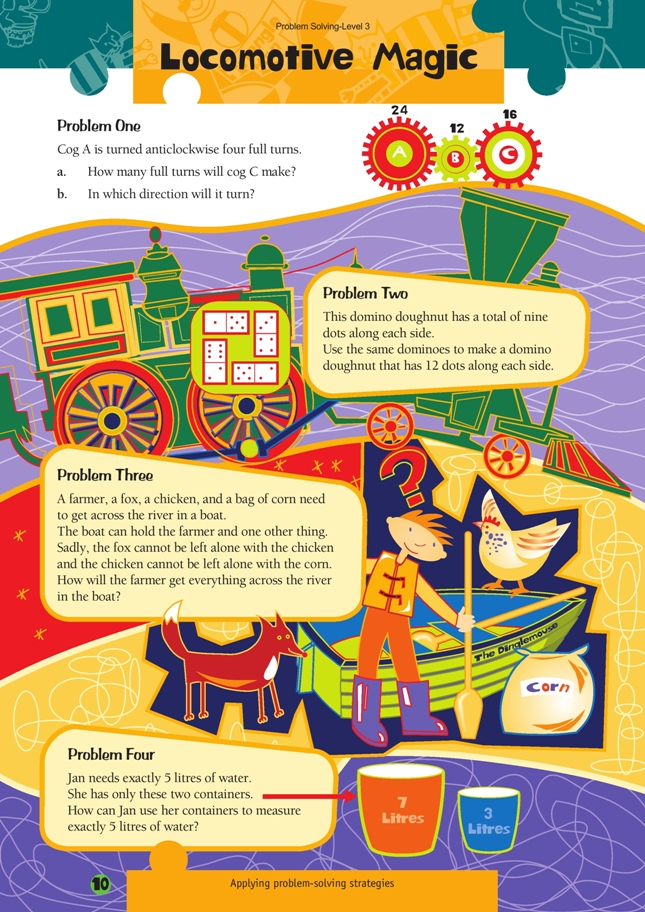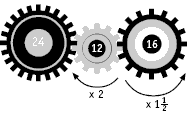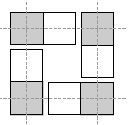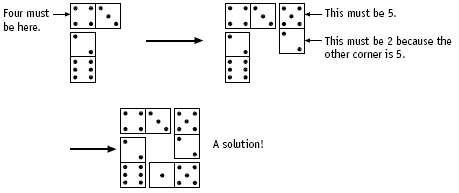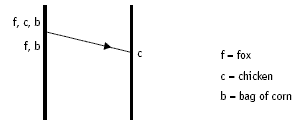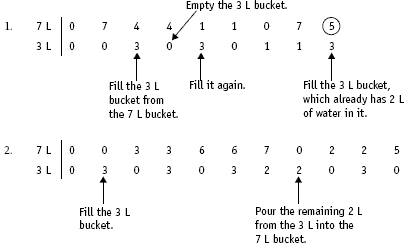These are level 4 and 5 number problems from the Figure It Out series.
A PDF of the student activity is included.
Click on the image to enlarge it. Click again to close. Download PDF (197 KB)
use ratios to solve problems (Problem 1)
use addition facts and logic to solve puzzles (Problem 2 and 4)
Problem One
In the gear train shown, cog B acts only as a transmitter. As cog A turns one turn anticlockwise, cog B will make two turns clockwise.
As cog B makes two turns clockwise, cog C will be driven to turn 11/2 turns anticlockwise. This happens because cog B has three-quarters the number of sprockets as cog C, so two turns of cog B make 1 1/2 turns of cog C.
Therefore, in four turns of cog A, cog C will turn 1 1/2 as many turns. 4 x 1 1/2 = 6 turns
Gear train relationships are easily observed in construction toys. They occur in many everyday situations, particularly in cars, bicycles, and motor-driven machinery.
Problem Two
Many students will find making a paper copy of the dominoes useful so that they can move them around to find a solution. Students who know the way dominoes are numbered should be able to use this logically to find a solution.
If the four sides each have 12 dots, this gives a sum of 4 x 12 = 48 dots. The dots in each corner square are counted twice to reach this 48-dot sum. In total, there are 28 dots on the four dominoes. The corner squares must account for the difference of 20 dots (48 – 28). Working on this premise, the only numbers that can go in the corner square are 5, 4, 5, and 6. Students can place the corner dots and then work out their solution knowing that the side total is 12 dots.
Problem Three
This traditional problem provides the ideal opportunity to use an act-it-out strategy. Students can assume the role of the characters and try out possible solutions. Alternatively, students could use counters for the characters or use some form of recording strategy. For example:
The only possible first move is to take the chicken across because all other trips leave a disastrous couple behind.
Two possible moves can occur in this next move: either the farmer returns to take the fox across or he returns to take the bag of corn across. The next move is to bring the chicken back as it cannot be left with either the fox or the bag of corn.
In either case, the chicken is brought back, the fox or the corn is taken across, and the farmer returns to pick up the chicken.
Problem Four
The problem can be acted out with cut-down plastic drink bottles used as the buckets.
A systematic recording strategy is needed to keep track of the quantities.
An important piece of reasoning is that the only way that 5 litres can be measured is if 2 litres are already in the 3 litre bucket or there is a way of pouring exactly 2 litres from a full 7 litre bucket.
Encourage students to use a structured recording system such as the one shown below:
Below are two possible solution strategies that use this recording system.
Answers to Problems
1. a. 6 full turns
b. anticlockwise
2. One solution:

3. One solution: The farmer takes the chicken to the other side of the river and leaves it there. He goes back and gets the fox. He leaves the fox on the other side of the river and takes the chicken back. He leaves the chicken on the bank, takes
the corn over to the other side, and leaves it with the fox. He then goes back and fetches the chicken.
Another solution follows the above for moving the chicken, but the trips for the corn and the fox are reversed.
4. One solution is to follow these steps:
• Fill the 7 L container.
• From the 7 L container, fill the 3 L container and then empty the 3 L container. Do this twice. There is now 1 L remaining in the 7 L container.
• Pour the remaining litre into the 3 L container.
• Refill the 7 L container.
• From the 7 L container, top up the 3 L container until it is full. There are now
exactly 5 L of water in the 7 L container.
Another solution:
• Fill the 3 L container. Pour this 3 L into the 7 L container. Do this twice. (There are now 6 L in the 7 L container.)
• Fill the 3 L container. Top up the 7 L container. This leaves 2 L in the 3 L
container.
• Empty the 7 L container. Pour the remaining 2 L from the 3 L container into the 7 L
container. Fill up the 3 L container again.
• Add the 3 L from the 3 L container to the 2 L in the 7 L container. There are now exactly 5 L of water in the 7 L container.
You may find other solutions.
